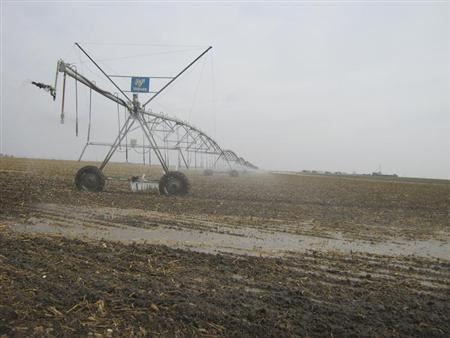
Reuters/Reuters – A sprinkler is in use near Dodge City, Kansas, November 26, 2012. REUTERS/Kevin Murphy
CHICAGO (Reuters) – Farmland values in the U.S. Plains states jumped more than 20 percent in the fourth quarter from a year earlier as farms sold at record-high prices, the Federal Reserve Bank of Kansas City said on Friday.
Irrigated cropland attracted the most interest, given the worst drought in 50 years in the world’s top food producer, the Kansas City Fed said.
This was the seventh consecutive quarter irrigated and non-irrigated cropland values posted year-over-year gains of more than 20 percent as record crop prices kept demand for farmland hot, according to a quarterly survey of bankers by the Kansas City Fed.
“Persistent drought sparked a rush in irrigated farmland sales during the fourth quarter of 2012. Stronger sales vaulted irrigated cropland values in the District 30 percent above year-ago levels, with a 13 percent jump in the fourth quarter alone,” the Fed said of its survey, which draws on comments from 232 district bankers.
Non-irrigated cropland and ranchland also posted strong annual gains between 20 and 25 percent.
The KC Fed district stretches across major wheat, corn and cattle states of Colorado, Kansas, Nebraska, Oklahoma and Wyoming along with parts of New Mexico and Missouri.
Farmland values are closely tracked by government economists as a gauge of the U.S. economy and health of the banking system. In recent years both crop prices and farmland prices have set records as the burgeoning biofuels industry and record food exports spotlighted the value of hard assets.
In turn, farm income has also set records. But skyrocketing land values have stirred banker fears about the possibility of a ruinous farmland bubble like the one seen in the 1980s U.S. farm crisis, when over-leveraged farmers lost their land when interest rates jumped.
The Kansas City district survey follows the Chicago and St. Louis Fed quarterly updates earlier this week covering the northern Corn Belt and central Delta states, with both reporting similar results – strong farm income aided by crop insurance and strong farm spending for land and equipment, partly due to year-end doubts about higher taxes in 2013.
Farmers remain the predominate land buyers, accounting for three-fourth of the sales in the Plains in the fourth quarter. Bankers said farmers used more cash to finance purchases compared to a year ago. Nonfarmers continued to buy land for investment purposes.
“Almost all recent auctions were sold to the largest farmers in the area wanting to get bigger. The buyers are strong and most are cash sales,” said one banker from northwest Missouri.
Farm incomes rebounded in the quarter despite expectations that drought would hurt profits, the KC Fed said.
“Crop incomes remained high, as farm operations with irrigated cropland had less yield loss and sold crops at high prices, while many farm operations without irrigation received crop insurance payments, mitigating losses,” the bank said.
Following the autumn harvest crop prices eased back as export demand weakened and ethanol production slowed, providing some relief to livestock producers through lower feed costs. Significantly, cattle and hogs firmed in the quarter improving profits in the livestock sector toward the end of 2012. The district contains the top cattle feedlot states, with the exception of Texas.
Higher farm incomes boosted capital spending and led to improved agricultural lending conditions, although overall loan demand remained low with many grain farmers flush with cash. Loan payment rates increased at a pace on par with a year ago while interest rates for operating and real estate loans edged lower, the bank survey said.
“Although fourth-quarter incomes were better than expected, bankers expressed concerns that drought could affect some areas further in coming months. Farm incomes were expected to drop in Kansas and Oklahoma, as pasture conditions generally remained poor due to ongoing drought. But strong farm incomes were expected to continue in areas with sufficient water availability,” the Fed said.
“Water scarcity led to differing farm incomes and farmland-value gains by state,” the bank added.
(Reporting by Christine Stebbins; Editing by Lisa Von Ahn, Peter Bohan and M.D. Golan)









